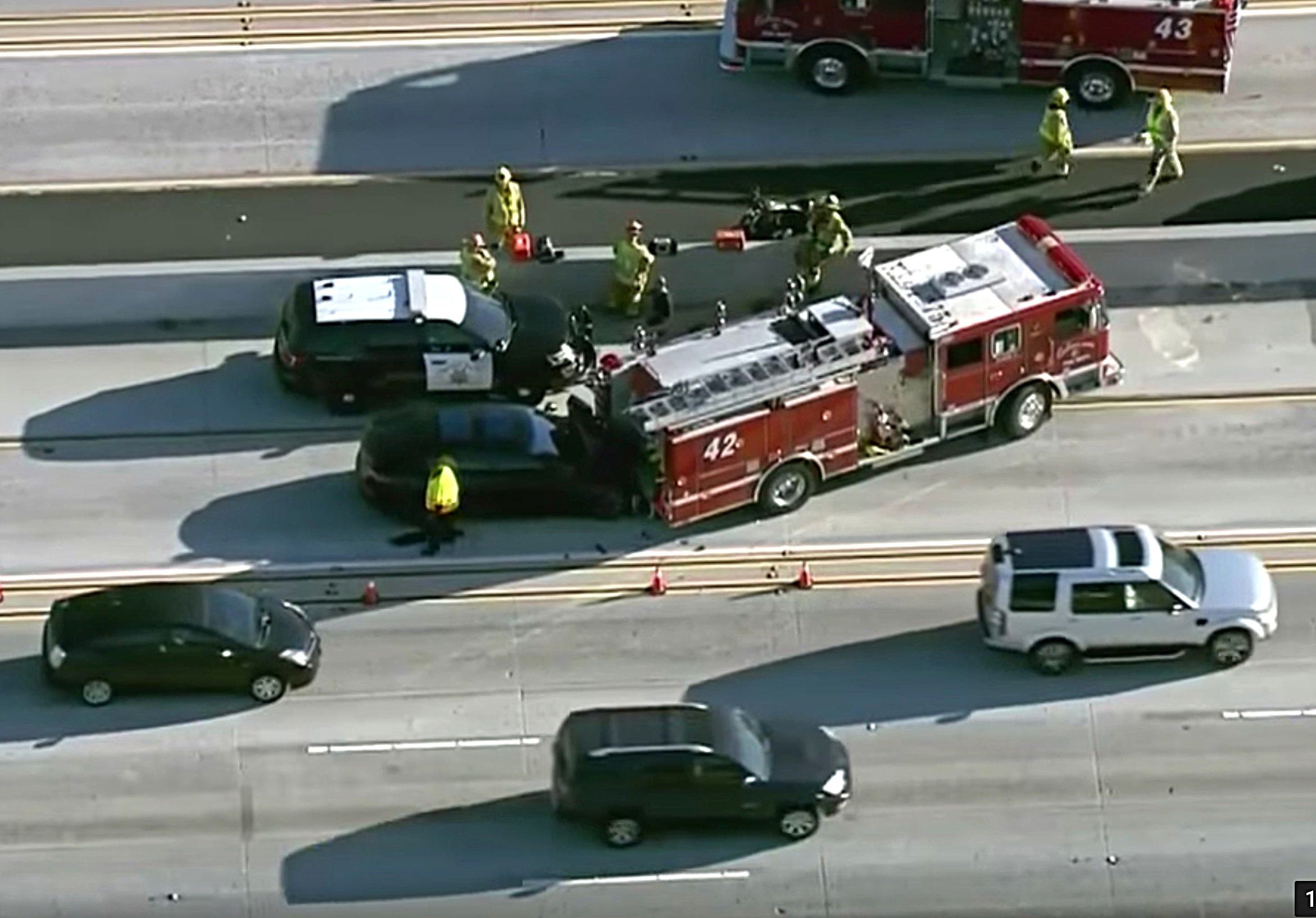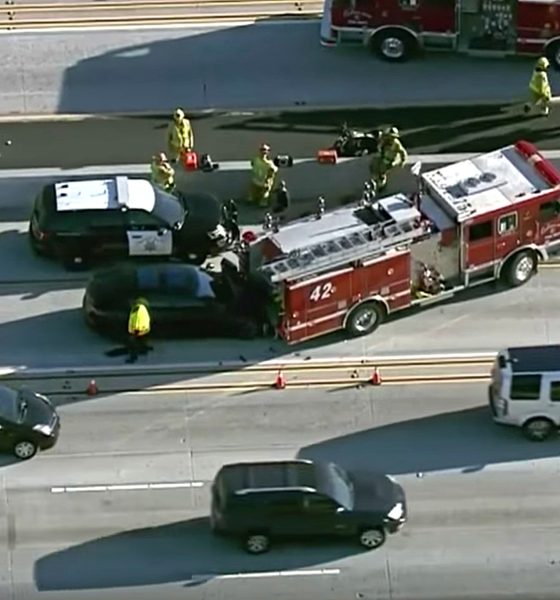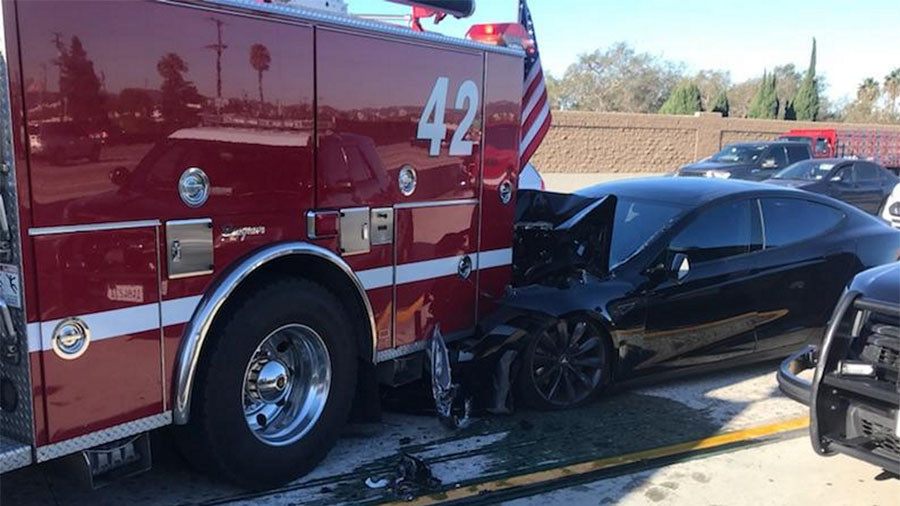

News
Tesla Model S firetruck crash in California: What we know so far
All eyes are on Tesla once more, after a Model S traveling at highway speeds crashed into a parked fire truck in Culver City, California earlier this week. The collision, which allegedly happened while the car was on Autopilot, has incited renewed debates, criticisms, and an upcoming government probe on Tesla and its evolving driving-assist software.
As more details about the accident emerge, here is a brief discussion on the latest and most pertinent information relating to the recent Model S collision.
The accident
As we stated in a previous report, the Tesla Model S was traveling at 65 mph on Interstate 405 on Monday morning when it crashed into a stationary fire truck. The emergency vehicle was parked on the road after being deployed to a separate accident in the area.
The driver of the electric car was able to walk away unharmed from the accident. Upon being questioned by the authorities, the Model S driver stated that the vehicle was on Autopilot when it collided with the parked fire truck. Tesla released a brief statement on Monday, stating that Autopilot is intended only to be used by an attentive driver.
More details emerge
As the online forum community continued to debate about the benefits and risks of Tesla’s Autopilot software, a member of the r/TeslaMotors subreddit who claimed to know the driver of the crashed Model S spoke up and provided some details about the accident. According to the Redditor, the Model S was traveling behind a pickup truck with Autopilot engaged. Due to the truck’s size, the Tesla’s driver was unable to see beyond the vehicle in front.
“The driver of the Tesla is my dad’s friend. He said that he was behind a pickup truck with AP engaged. The pickup truck suddenly swerved into the right lane because of the firetruck parked ahead. Because the pickup truck was too high to see over, he didn’t have enough time to react.” notes mikhpat.

Tesla Model S crashes into a stationary firetruck [Credit: Culver City Fire Department via Twitter]
Tesla’s Autopilot system allegedly did not have enough time to react while driving at 65 mph. The driver stated that the Model S’ emergency braking system might have activated moments before the car hit the emergency vehicle, but he could not be certain, according to mikhpat‘s statement.
“As for the 65mph detail, the braking system could’ve intervened before the collision, but there’s no way he could tell.”
The impact was strong enough to push the steering wheel two feet into the cabin, however. The Model S driver had some minor cuts and bruises from the accident but was otherwise unharmed. According to the Redditor, the driver admits that he was at fault for not paying close attention to the road. The Model S owner also refused to blame Tesla for the accident.
While it’s still unconfirmed if Tesla’s Autopilot suite, including Traffic-Aware Cruise Control and Autosteer, was activated at the time of the accident, Tesla’s Model S Owner’s Manual warns of a similar scenario that would not be detected by the driving-assist system.
According to the About Drive Assistance section of the owner’s manual:
“Traffic-Aware Cruise Control cannot detect all objects and may not brake/decelerate for stationary vehicles, especially in situations when you are driving over 50 mph (80 km/h) and a vehicle you are following moves out of your driving path and a stationary vehicle or object is in front of you instead.”
The warning appears to mimic the exact situation being described by Redditor mikhpat.
The investigations begin
As the online forum community exploded amidst heated debates on who is to blame for the recent Model S collision, the US National Transportation Safety Board announced that it is sending two of its investigators to California to study the crash. According to the NTSB, the investigators will be examining both “driver and vehicle” factors in Monday’s accident.
By Tuesday, the National Highway Traffic Safety Administration announced that it is also sending a team of investigators to California to evaluate the recent accident, as well as to assess any “lessons learned” from the crash, as noted in a Bloomberg report. The NHTSA did not specify which team of investigators it was sending to California, but expectations are high that the regulating body would be deploying its Special Crash Investigations unit.

News
Tesla FSD fleet is nearing 7 billion total miles, including 2.5 billion city miles
As can be seen on Tesla’s official FSD webpage, vehicles equipped with the system have now navigated over 6.99 billion miles.

Tesla’s Full Self-Driving (Supervised) fleet is closing in on almost 7 billion total miles driven, as per data posted by the company on its official FSD webpage.
These figures hint at the massive scale of data fueling Tesla’s rapid FSD improvements, which have been quite notable as of late.
FSD mileage milestones
As can be seen on Tesla’s official FSD webpage, vehicles equipped with the system have now navigated over 6.99 billion miles. Tesla owner and avid FSD tester Whole Mars Catalog also shared a screenshot indicating that from the nearly 7 billion miles traveled by the FSD fleet, more than 2.5 billion miles were driven inside cities.
City miles are particularly valuable for complex urban scenarios like unprotected turns, pedestrian interactions, and traffic lights. This is also the difference-maker for FSD, as only complex solutions, such as Waymo’s self-driving taxis, operate similarly on inner-city streets. And even then, incidents such as the San Francisco blackouts have proven challenging for sensor-rich vehicles like Waymos.
Tesla’s data edge
Tesla has a number of advantages in the autonomous vehicle sector, one of which is the size of its fleet and the number of vehicles training FSD on real-world roads. Tesla’s nearly 7 billion FSD miles then allow the company to roll out updates that make its vehicles behave like they are being driven by experienced drivers, even if they are operating on their own.
So notable are Tesla’s improvements to FSD that NVIDIA Director of Robotics Jim Fan, after experiencing FSD v14, noted that the system is the first AI that passes what he described as a “Physical Turing Test.”
“Despite knowing exactly how robot learning works, I still find it magical watching the steering wheel turn by itself. First it feels surreal, next it becomes routine. Then, like the smartphone, taking it away actively hurts. This is how humanity gets rewired and glued to god-like technologies,” Fan wrote in a post on X.
News
Tesla starts showing how FSD will change lives in Europe
Local officials tested the system on narrow country roads and were impressed by FSD’s smooth, human-like driving, with some calling the service a game-changer for everyday life in areas that are far from urban centers.

Tesla has launched Europe’s first public shuttle service using Full Self-Driving (Supervised) in the rural Eifelkreis Bitburg-Prüm region of Germany, demonstrating how the technology can restore independence and mobility for people who struggle with limited transport options.
Local officials tested the system on narrow country roads and were impressed by FSD’s smooth, human-like driving, with some calling the service a game-changer for everyday life in areas that are far from urban centers.
Officials see real impact on rural residents
Arzfeld Mayor Johannes Kuhl and District Administrator Andreas Kruppert personally tested the Tesla shuttle service. This allowed them to see just how well FSD navigated winding lanes and rural roads confidently. Kruppert said, “Autonomous driving sounds like science fiction to many, but we simply see here that it works totally well in rural regions too.” Kuhl, for his part, also noted that FSD “feels like a very experienced driver.”
The pilot complements the area’s “Citizen Bus” program, which provides on-demand rides for elderly residents who can no longer drive themselves. Tesla Europe shared a video of a demonstration of the service, highlighting how FSD gives people their freedom back, even in places where public transport is not as prevalent.
What the Ministry for Economic Affairs and Transport says
Rhineland-Palatinate’s Minister Daniela Schmitt supported the project, praising the collaboration that made this “first of its kind in Europe” possible. As per the ministry, the rural rollout for the service shows FSD’s potential beyond major cities, and it delivers tangible benefits like grocery runs, doctor visits, and social connections for isolated residents.
“Reliable and flexible mobility is especially vital in rural areas. With the launch of a shuttle service using self-driving vehicles (FSD supervised) by Tesla in the Eifelkreis Bitburg-Prüm, an innovative pilot project is now getting underway that complements local community bus services. It is the first project of its kind in Europe.
“The result is a real gain for rural mobility: greater accessibility, more flexibility and tangible benefits for everyday life. A strong signal for innovation, cooperation and future-oriented mobility beyond urban centers,” the ministry wrote in a LinkedIn post.
News
Tesla China quietly posts Robotaxi-related job listing
Tesla China is currently seeking a Low Voltage Electrical Engineer to work on circuit board design for the company’s autonomous vehicles.

Tesla has posted a new job listing in Shanghai explicitly tied to its Robotaxi program, fueling speculation that the company is preparing to launch its dedicated autonomous ride-hailing service in China.
As noted in the listing, Tesla China is currently seeking a Low Voltage Electrical Engineer to work on circuit board design for the company’s autonomous vehicles.
Robotaxi-specific role
The listing, which was shared on social media platform X by industry watcher @tslaming, suggested that Tesla China is looking to fill the role urgently. The job listing itself specifically mentions that the person hired for the role will be working on the Low Voltage Hardware team, which would design the circuit boards that would serve as the nervous system of the Robotaxi.
Key tasks for the role, as indicated in the job listing, include collaboration with PCB layout, firmware, mechanical, program management, and validation teams, among other responsibilities. The role is based in Shanghai.
China Robotaxi launch
China represents a massive potential market for robotaxis, with its dense urban centers and supportive policies in select cities. Tesla has limited permission to roll out FSD in the country, though despite this, its vehicles have been hailed as among the best in the market when it comes to autonomous features. So far, at least, it appears that China supports Tesla’s FSD and Robotaxi rollout.
This was hinted at in November, when Tesla brought the Cybercab to the 8th China International Import Expo (CIIE) in Shanghai, marking the first time that the autonomous two-seater was brought to the Asia-Pacific region. The vehicle, despite not having a release date in China, received a significant amount of interest among the event’s attendees.








